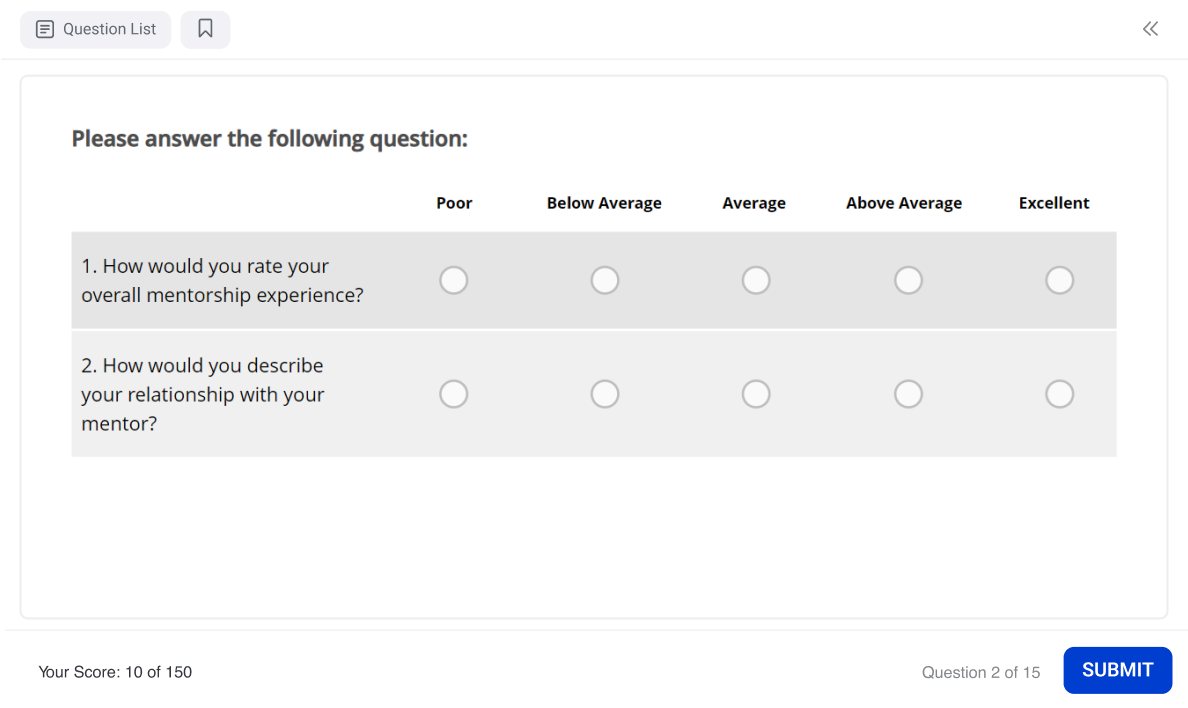Peer-to-Peer Learning: How to Implement It in Your Company

Research performed by SHRM on workplace L&D trends shows that employees see up-to-date and socially engaging training as key factors in making training more effective.
L&D teams are adopting peer-to-peer learning to boost employee engagement, reduce training costs, and foster stronger connections for a better workplace.
Peer-to-peer learning is also a solution for industries in which skill demands constantly evolve, requiring professionals (and training programs) to adapt quickly and efficiently.

What Is Peer-to-Peer Learning?
In a corporate setting, peer-to-peer learning refers to training that takes place among employees, rather than being delivered by a manager or an external trainer. Simply put, this is a type of learning wherein one employee shares knowledge with others.
As the name suggests, relations between participants are based on the “peer-to-peer” principle. The educational process is built upon the concepts of equality and mutual learning.
Peer-to-peer learning has its roots in the so-called “Monitorial System.” This is also known as the “Bell–Lancaster method” — named after the British educators Andrew Bell and Joseph Lancaster, who both developed it independently.
This method was used to teach children in Great Britain in the 19th century. Because of the teacher shortage the country was facing at that time, high school students had to teach younger children. This helped relieve some of the teachers’ burdens and engage children in the learning process. Older students felt their importance and responsibility for their wards, while younger students engaged with their teachers as equals.

This is what the classrooms looked like, where children were taught according to the Monitorial System. Each shared table and bench was assigned to a group of students with a peer teacher.
Benefits of Peer-to-Peer Learning for Business
Now let’s look at the benefits of peer-to-peer training in more detail.
Cost-effective, scalable knowledge sharing
Typically, companies spend hundreds of thousands of dollars to create a training program. The program may not be sufficiently engaging and might become outdated by the end of the year.
According to research performed by SHRM on workplace L&D trends, difficulty keeping content up to date amid workplace change is one of the top challenges for HR and L&D teams. A third of employees say they have trouble staying motivated with training at work.
A peer-to-peer learning approach allows organizations to tap into internal expertise instead of relying on external instructional designers or spending hundreds of hours on content development.
Internal experts can share insights in real time or through short, informal lessons. With the right motivation and symbolic rewards, companies can encourage knowledge sharing at no additional cost.
This approach not only saves money but also offers a scalable learning solution that evolves with increased user interactions.
Boosting employee engagement and collaboration
Sharing knowledge and learning from colleagues not only enhances new skills but also strengthens workplace relationships. When employees feel more connected, turnover rates decrease, productivity rises, and engagement in company initiatives improves — ultimately leading to enhanced work quality.
Stronger connections also create a more welcoming and supportive work environment, making employees look forward to coming in each day.
Encouraging innovation and continuous learning
When team members share their real-world experiences and brainstorm together, they naturally generate new ideas and find solutions that would never be achieved with traditional training.
When everyone can request and create educational content, you’re creating an environment where continuous learning happens organically. People gain new perspectives through collaboration, naturally develop cross-skills, and solve problems together instead of facing them alone.
Plus, these collaborative exchanges build precisely the communication and leadership skills your future leaders need, such as listening skills or problem-solving.
How to Implement Peer-to-Peer Learning in the Workplace
As you can see, peer-to-peer learning can be an affordable yet powerful tool that companies can use to train employees. Here are 3 principle ways you can start implementing peer-to-peer learning programs:
Organize group learning
Group learning is a peer-to-peer learning approach wherein professionals of similar levels share experiences, solve problems together, and learn from each other’s real-world insights in a structured, collaborative environment that promotes knowledge exchange and professional development.
Where can you start with this approach?
1. Build the right team composition
When putting together your peer learning groups, make sure that participants are at similar seniority levels so their educational experiences and challenges resonate with each other. This creates relevance and ensures that everyone can contribute meaningfully to group discussions.
2. Select effective facilitators
Choose someone who can guide discussion seminars, keep conversations on track, and encourage collaboration beyond formal learning. This person will also help with the admin side of peer-to-peer learning and the measurement of results.
3. Create a psychologically safe environment
For peer learning to work, participants need to feel safe sharing challenges without fear of repercussions. Keep managers separate from their direct reports’ peer groups and establish clear confidentiality rules. Make sure everyone has a comfortable space to participate in, especially for online learning sessions.
4. Structure repeatable training activities
Implement structured activities that can be repeated easily. Here are some examples from sales training:
- Practice training sessions during which team members can navigate role-play scenarios and provide constructive feedback
- Content sharing of successful materials and templates from real deals
- Review sessions for analyzing calls, deals, wins, and losses
- Asynchronous feedback opportunities where peers can review each other’s work on their own time
Support internal experts in knowledge-sharing
SME-generated content is a key digital learning trend for 2026. To encourage internal SMEs to contribute without disrupting their core responsibilities, organizations should provide the appropriate support and motivation. Here’s what helps to make it effective:
- Get buy-in. Explain how knowledge sharing benefits both the organization and the SME personally. Emphasize that sharing expertise drives innovation and operational excellence while positioning them as thought leaders.
Implement formal recognition programs that acknowledge contributors through company announcements, awards, or opportunities for advancement. - Provide templates. Create standardized formats (e.g., presentation outlines, document templates, and recording guides) that reduce preparation time drastically. Develop clear guidelines with best practices for effective knowledge delivery and sample materials.
- Leverage technology. Choose a simple authoring solution so experts can create content either on their own or with minimal support. By the way, iSpring Suite is such a solution. It’s a PowerPoint authoring tool that extends beyond PowerPoint’s existing features.
This is what one of our customers shared on G2:
“At the Military Medical Institute -State Research Institute, since iSpring Suite began to be used, the creation of the course can be carried out by the Content Author, which makes the course itself as faithful as possible to the author’s ideas.”
- Minimize their involvement where possible. Assign dedicated support staff to handle the administrative aspects of content creation. Simplify the process by breaking knowledge sharing down into microlearning modules (5–15 minutes each) that require minimal preparation.
Additionally, implement a rotation system among multiple experts to distribute the teaching load evenly and prevent burnout.
Manage peer-to-peer mentorship and coaching
Another peer-to-peer learning option is to support experienced colleagues to become mentors and coaches.
- Sell them on the “why”. You can motivate mentors with the help of both material and non-material incentives. For example, you can promise a monthly salary increase for new hires who have passed the probation period or reward a mentor with a certificate and put their photo on an employee honor board. This all depends on your corporate culture.
- Appoint a project manager. A project manager will be your peer-to-peer learning facilitator. They will solve organizational problems, encourage peer learning in the workplace, and assume full control of the process. Besides, managers usually take on responsibilities such as collecting feedback from employees and measuring peer training effectiveness.
- Provide training on mentorship/coaching. Remember that technical expertise doesn’t automatically translate to peer teaching ability — mentors need specific communication skills to build trust, maintain boundaries, and guide development without creating dependency.
“Matching people based on shared interests or similar backgrounds can lead to stronger working relationships — and often, better collaboration. When two people see parts of themselves in each other, it becomes easier to listen, to trust, and to learn. Common goals, similar experiences, overlapping responsibilities, or even a shared hobby can help a mentoring relationship feel natural instead of assigned. Encouraging employees to share a little personal information on their profiles can make these kinds of connections easier to find.”
- Match employees carefully. Pairing mentors and mentees (or coaches and coachees) is one of the most challenging tasks that a project manager will perform because people may have different backgrounds, career goals, and their own learning styles.
“Collaboration works best when people feel comfortable contributing. In shared digital workspaces, teammates can exchange ideas, give feedback, offer help, and move projects forward together — without needing to be in the same room. The tools matter, but the feeling of working alongside others matters more. Done well, this kind of environment builds more than just efficiency. It builds trust, a sense of purpose, and the kind of teamwork that lasts beyond a single task.”
Peer Learning Challenges and How to Overcome Them
Here are two common challenges in peer-to-peer learning and tips on how to minimize their impact:
Addressing resistance and encouraging active participants
As with any significant change, there may be initial resistance from individuals who are comfortable with the existing system.
You can’t expect your peer-to-peer learning strategies to work to their full potential without promoting them in your workplace. Here are a few ways to encourage employees to share their own knowledge and provide mutual support to coworkers:
- Promote the benefits of peer-to-peer learning throughout the organization.
- Spotlight peer teaching relationships in the company.
- Support and motivate employees who initiate and encourage peer-to-peer learning.
- Create a digital space for employees to discuss topics.
Measuring the success of peer learning
The process is pretty straightforward if we are talking about measuring the impact of content created by internal experts. There is a clear start and end. As a result, the process is similar to evaluating any other course from your training program.
Things are far more complex when it comes to peer-to-peer learning and mentorship/coaching in groups. This is because the learning process isn’t standardized and relies on human interaction, causing the impact to vary from person to person.
How can you measure the success of peer instruction? Here are several peer assessment schemes.
1. Surveys. Gather feedback from participants about their experience. For example, you can ask your mentees to complete a survey in which they need to rate the mentor’s work, describe the challenges they faced, and make suggestions on how training can be improved.

This survey was created with iSpring Suite.
2. Interviews. Another way to learn the degree to which employees are satisfied with the training is to ask them to share their impressions in a one-to-one meeting. This can uncover unexpected insights compared to the options in the survey.
3. Student performance improvements. For example, if you’re organizing structured peer-to-peer learning for the sales department, you can then measure metrics such as deal progression speed and conversion rate improvements. You can also measure individual performance in general and in specific skills if we’re talking about peer coaching and mentorship.
4. Compare employee satisfaction, performance improvements, and costs of peer-to-peer learning programs with traditional training methods.
Success Stories and Peer-to-Peer Learning Best Practices
Here are some examples of companies that are successfully using peer-to-peer learning theory in training, provided for inspiration.
One of their programs was the Conscious Business program, which represented a structured, yet flexible four-week learning experience to build new skills. Each week, participants received a short video with a question to be discussed. Then they got an assignment to practice the learned skill with a peer in their group. After the week’s activities, the group joined a live one-hour video session, where a facilitator guided the discussion.

At Google, 80% of all tracked training programs are delivered through an employee-to-employee learning network called “g2g” (Googler-to-Googler). This volunteer-driven network, consisting of over 6,000 Google employees, dedicates a portion of each volunteer’s time to helping colleagues learn and grow.
Known as “g2g’ers,” these volunteers from all departments across the company contribute in a variety of ways, including teaching courses, offering 1:1 peer mentoring, and creating learning materials.

Remove barriers to entry. Google trusted its employees to do great work and created a quality assurance process based on the assumption that people would succeed, rather than fail. By removing multiple initial prerequisites and focusing on program-specific requirements, volunteer participation in the g2g program doubled in six months without compromising quality. Over time, Google continued to remove barriers and provide more support groups, further enhancing participation and quality.
Secure leadership support, not just permission. Google realized that for g2g to succeed, managers needed to actively support, not just permit, employee participation. By providing data on the program’s value, Google shifted the company culture to encourage managers to make time for employees to engage in peer learning. This ensured that participation was seen as being beneficial to the organization.
Find more insights in Google’s guide on an employee-to-employee learning program.
Marley Spoon
Marley Spoon organized peer learning programs as a part of its training program. Employees are simply encouraged and supported to create topics that interest them.
To become a teacher, an employee has a call with the L&D Manager and then goes through their Train the Trainer session to ensure a socially interactive session. After each training session, feedback is gathered from learners to help the trainers improve. Using the same feedback form for all learning sessions keeps the data in one place.
Trainers are rewarded with a nice dinner twice a year.

- Start by identifying passionate ambassadors who can help kick off the peer learning programs.
- Ensure that your train-the-trainer sessions emphasize an interactive, social learning environment rather than passive presentations.
- To address time management and workload challenges, make trainings recurring and announce them in advance, allowing participants to schedule them. C-level involvement also helps to communicate the program’s importance and encourages active participation.
Wrapping Up
Peer-to-peer learning can be an effective and affordable option to train employees. It not only helps human resources attain career success but also supports organizations to retain their best talent, increase employee job satisfaction, and foster the company culture of learning.
As you might have noticed from the peer-to-peer learning examples, many organizations strive for a hybrid approach combining live communication and asynchronous online courses. This is the optimal solution if you want to engage more trainers and learners, taking time constraints and different time zones into account.
iSpring LMS learning management system might be a perfect fit for such hybrid learning (or blended learning) in your company. It offers smooth video conferencing tools, integrations, and gamification features and has simple, yet comprehensive content creation tools in the same ecosystem. You can try iSpring LMS during the 30-day free trial or first request a live demo.






